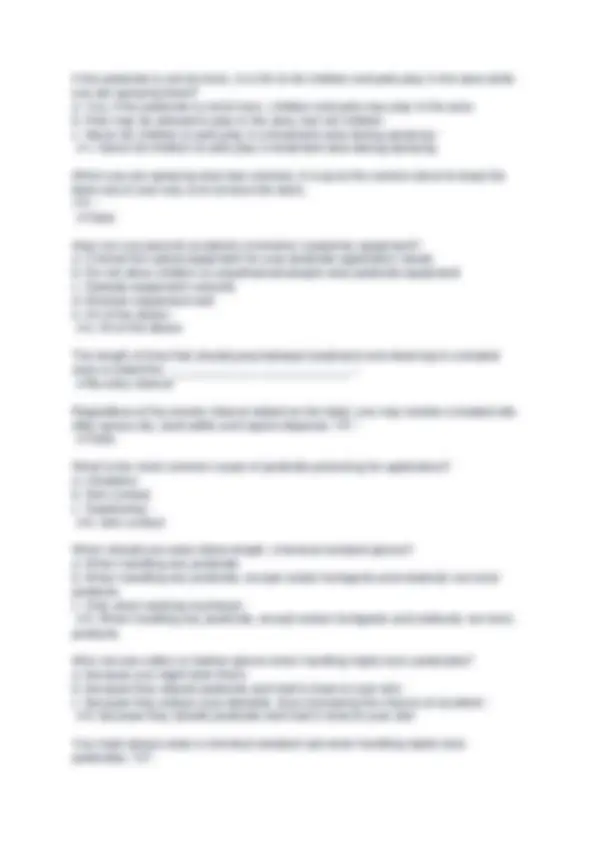

















Study with the several resources on Docsity

Earn points by helping other students or get them with a premium plan


Prepare for your exams
Study with the several resources on Docsity

Earn points to download
Earn points by helping other students or get them with a premium plan
Community
Ask the community for help and clear up your study doubts
Discover the best universities in your country according to Docsity users
Free resources
Download our free guides on studying techniques, anxiety management strategies, and thesis advice from Docsity tutors
A comprehensive set of questions and answers related to the pesticide applicator general exam. It covers various topics such as licensing, agency responsibilities, application categories, pesticide regulations, toxicity, exposure, and safety measures. It also includes information about signal words, tolerances, and consequences of pesticide drift. Essential for anyone preparing for the pesticide applicator general exam.
Typology: Exams
1 / 23

This page cannot be seen from the preview
Don't miss anything!
















If unsupervised, you must have a license to legally work with restricted pesticides, but not to work with state-limited pesticides. T/F - ✔️False To legally perform structural pest control, you must have a license regardless of the kinds of pesticides you use. T/F - ✔️True Which is not an agency that shares responsibility for pesticide applicator training, certification and licensing? a. Texas department of Agriculture (TDA) b. Texas Structural Pest Control Service (SPCS) c. Texas A&M AgriLife Research - ✔️c. Texas A&M AgriLife Research Which licnese must be obtained by a person who wants to perform pest control as an employee of a privately owned apartment building or hospital? a. A business license from SPCS b. A noncommercial license from SPCS c. A private license from either TDA or the SPCS d. none of the above - ✔️b. A noncommercial license from SPCS To work for hire, using restricted or state-limited pesticides on another person's land, you must have: a. A business license from the TDA b. A commercial license from the TDA c. A private license from the TDA d. All of the above - ✔️b. A commercial license from the TDA All licensed commercial and noncommercial applicators must be certified in each application category in which they practice. T/F - ✔️True Which of the following is not among the TDA application categories? a. Right of way b. Predatory animal c. Wood preservation d. Fumigation - ✔️c. wood preservation Which of the following is not among the SPCS application categories?
a. Termite b. Seed treatment c. Wood preservation d. Commodity fumigation - ✔️b. Seed Treatment Which of the following state agencies is not involved in pesticides regulations? a. Texas department of agriculture b. Texas A&M Agrilife extension service c. Texas commission of Environmental quality - ✔️b. Texas A&M agrilife extension service Under the Texas Pesticide Law, Pesticides used in this state must be registered with the TDA, even if they are already registered with the U.S. Environmental Protection Agency. T/F - ✔️True _______ ________ is your responsibility to inform nearby residents or adjacent landowners before you apply pesticides. - ✔️Prior notification In addition of the state government, even county commissioners courts may set rules on the use of certain pesticides. T/F - ✔️True Even with a commercial applicator license, you must still obtain a spray permit before using regulated herbicides. T/F - ✔️True Specialty fertilizer in containers with capacities of 50 pounds or less that are labeled for ornamental and turf use are exempt from classification as state-limited-use pesticides or regulated herbicides. T/F - ✔️True The Texas Structural Pest Control Act requires you to give public notice at least ______ hours before commencing indoor pesticide treatments. - ✔️48 hours Which agency enforces the Texas Solid Waste Disposal Act? a. TDA b. Texas Commission on Environmental Quality c. Texas Commission on Aging d. Texas hazardous Waste Commission - ✔️b. Texas Commission on Environmental Quality What is the full name and acronym of the federal agency that regulates pesticides: a. U.S. Department of Agriculture (USDA) b. Office of Pesticide Programs (OPP) c. Federal Insecticide, Fungicide, and Rodenticide Agency (FIFRA)
✔️c. Fist and Wildlife Services (FWS) of the Department of the Interior Who ultimately bears the responsibility of protecting endangered species from pesticides? a. The federal government b. The state government c. Conservationists d. You, the applicator - ✔️d. You, the applicator _________ is the capacity of a substance to injure or poison a living system, such as a human being, an animal, a lake, or a forest. - ✔️Toxicity What is pesticide exposure? a. Coming in contact with a pesticide b. Being poisoned by a pesticide c. Neither of the above d. Both of the above - ✔️a. Coming in contact with a pesticide _________ _________ refers to how poisonous a pesticide is after short-term exposure. - ✔️Acute toxicity _________ _________ is a one-time or short-term contact with pesticide. - ✔️Acute exposure __________ __________ is a delayed poisonous effect from exposure to a substance. - ✔️Chronic toxicity _________ _________ is long-term repeated contact with pesticides. - ✔️Chronic exposure The effects of which type of exposure---acute or chronic--- can be more easily detected and studied? - ✔️Acute A pesticide dose is the _________ of pesticide of which a surface, plant or animal is exposed. - ✔️Amount Name the three routes by which pesticide can enter your body. - ✔️Dermal , oral , inhalation Some pesticide are poisonous no matter how they enter the body. T/F - ✔️True
Which pesticide solution is most likely to be absorbed through the skin? a. Oil-based b. Water-based c. Dry - ✔️a. Oil-based Which areas of the body absorb pesticides quickly? a. Feet, hands, head, and groin b. Scalp, nose, hands, and arms c. Face, hands, torso, and scalp d. Eyes, ears, scalp, and genitals - ✔️d. Eyes, ears, scalp, and genitals Which two routes of entry are likely to be the most important to you? a. Dermal and oral b. Dermal and inhalation c. Inhalation and oral d. None of the above - ✔️b. Dermal and inhalation Which factor affects the toxicity of a pesticide? a. Route of entry b. frequency and duration (rate) of exposure c. Does received d. All of the above - ✔️d. All of the above An example of a chronic effect is the drop in __________, an essential body enzyme, caused by organophosphates and carbamates. - ✔️Cholinesterase ___________ effects occur at the site of contact with a pesticide while ___________ effects occur away from the point of contact. - ✔️Local, systemic Skin rash, nausea, eye irritation, and dizziness are examples of ___________ toxic effects. - ✔️Reversible LD 50 means "lethal dose fifty" it refers to the amount of chemical that kills __________ the animals exposed to it in a laboratory test. - ✔️half (50%) The smaller the LD 50 value, the less chemical required to fatal, so the more poisonous the pesticide. T/F - ✔️True Acute oral toxicity and acute dermal toxicity are measured as LD 50. The higher the LD 50 the ___________ (more or less) toxic the pesticide. - ✔️Less
b. Yes, no matter how it is handled a highly toxic material is always hazardous. - ✔️a. No, if a highly toxic material is handled properly it could actually pose low risk or hazard. Which of the statements below is not true about a pesticide deposit? a. A deposit is pesticide that remains on treated surfaces right after application. b. Pesticide deposits may or may not be seen easily. c. Most deposits remain on surfaces for a very long time. - ✔️c. Most deposits remain on surfaces for a very long time. Which of the statements below is not true about a pesticide residue? a. Some residues may remain for months or years. b. Residue information is required for each crop you treat. c. residues are found only on target crops and surfaces. - ✔️Residues are found only on target crops and surfaces. A __________ is the maximum amount of pesticide residue allowed on a harvested crop, set by the EPA. - ✔️Tolerance Can a harvested crop contain more than the set tolerance of a pesticide and still be legally sold? a. No, it cannot be legally sold b. Yes, it may be sold if it is not condemned or seized. c. Yes, it may be sold if it is identified as contaminated. - ✔️No, it cannot be legally sold. What margin of safety ("safety factor") does the EPA use to set tolerances? a. 10 times b. 100 times c. 1,000 times - ✔️b. 100 times Food may have no residues at all because the residues may have degraded or the crop may have been treated with a minimum dose of a pesticide. T/F - ✔️True Soil and plant surfaces may contain pesticide residue even when they are not directly sprayed with the pesticide. T/F - ✔️True EPA sets two kinds of tolerances: __________ __________ tolerances for pesticides that indirectly contact food; and tolerances for pesticides applied directly for food. - ✔️Negligible residue, finite "Preslaughter interval" or "preharvest interval" refers to the ____________ number of days allowed between the last pesticide application and the slaughter or harvest day. a. least b. most -
✔️Least No pesticide my be bought, sold or used in the U.S. until it has federal registration for the product, the use and the label. T/F - ✔️True Sometimes even small environmental changes can greatly reduce the chances of survival for fish and wildlife. T/F - ✔️True When a pesticide evaporates and moves off target, this is called __________ __________ - ✔️Vapor drift Which of these additional factors does not influence drift? a. Particle size b. Pollution c. Nozzle design and orientation d. Temperature - ✔️b. Pollution Which of these additional factors does not influence drift? a. Humidity b. Height of release c. Wind speed and direction d. Reentry interval - ✔️Reentry interval Why should honeybees be protected? a. Because they are the most important beneficial insect b. Because poisoned bees are more dangerous to people and animals c. Because their work as pollinators is necessary for crop production - ✔️c. Because their work as pollinators is necessary for crop production Pesticide residues can build up in the bodies of animals, including man. T/F - ✔️True Only pesticides that are applied incorrectly are likely to move downward with rain or irrigation water into the water table below. T/F - ✔️False A pesticide becomes a pollutant and potentially dangerous when it is applied at a higher dose than recommended on the label or when it drifts off target. T/F - ✔️True How should you change pressure to reduce liquid droplet drift? a. Reduce pressure to increase droplet size b. Increase pressure to increase droplet size c. Reduce pressure to reduce droplet size d. Increase pressure to reduce droplet size -
Even though persistent pesticides remain in the environment, they do not always accumulate in animals or plants. T/F - ✔️True An ___________ ____________ is a plant or animal that is near extinction throughout all of most of its range. - ✔️Endangered species Which of the following is not a process that causes pesticides to break down after applications? a. Photodegradation b. Microbial degradation c. Chemical degradation d. Atmospheric degradation - ✔️d. Atmospheric degradation Pesticides that degrade ___________ in the environment are the least hazardous. a. Slowly b. Quickly c. At a moderate rate - ✔️Quickly Sometimes even small environmental changes can greatly reduce the chances of survival for fish and wildlife. T/F - ✔️True When a pesticide evaporates and moves off target, this is called _____________ ______________. - ✔️Vapor drift Which of these factors does not influence drift? a. Particle size b. Pollution c. Nozzle design and orientation d. Temperature - ✔️b. Pollution Which of these additional factors does not influence drift? a. Humidity b. Height of release c. Wind speed and direction d. Re entry interval - ✔️d. Re entry interval Why should honeybees be protected? a. because they are the most important beneficial insect b. because poisoned bees are more dangerous to people and animals c. because their work as pollinators is necessary for crop production - ✔️c. because their work as pollinators is necessary for crop production
Pesticide residues can build up in the bodies of animals, including man. T/F - ✔️True Only pesticides that are applied incorrectly are likely to move downward with rain or irrigation water into the water table below. T/F - ✔️False A pesticide becomes a pollutant and potentially dangerous when it is applied at a higher dose than recommended on the label or when it drifts off target. T/F - ✔️True How should you change pressure to reduce liquid droplet drift? a. Reduce pressure to increase droplet size b. Increase pressure to increase droplet size c. Reduce pressure to reduce droplet size d. Increase pressure to reduce droplet size - ✔️a. reduce pressure to increase droplet size What are the possible consequences of pesticide drift onto forage and pastureland or into drinking water? a. people, pets and livestock can be injured by pesticide exposure. b. Pasture grasses could be destroyed c. Milk or meat could have illegal residues if cattle eat contaminated forage d. Water may become too contaminated to drink e. All of the above - ✔️e. all of the above Pesticide pollution can help a pest you are trying to destroy by killing predators and parasites of the pest. T/F - ✔️True An __________ is a geologic formation of permeable rock, and sand, or gravel that stores large amounts of water. - ✔️Aquifer Why are aquifers important? a. Because they are the main water supply for manufacturing industries b. Because so many people use water from aquifers for drinking c. Because building and maintaining them provides jobs - ✔️b. Because so many people use water from aquifers for drinking What is the name given to the complex prey/predator cycle in which all animals (including man) take part? a. food chain b. habitat c. ecosystem - ✔️a. food chain The best protection against groundwater pollution is ___________. -
How should you clean your washing machine after laundering pesticide soiled clothing? a. Run a complete, but empty cycle using hot water and detergent. b. Clean the inside of the machine by hand c. Run a rinse cycle only. - ✔️a. Run a complete, but empty cycle using hot water and detergent. The safest way to move pesticides is in the back of a truck that has a steel bed with enclosed sides and a tail gate. T/F - ✔️True You should wear a wide brimmed, chemical resistant, waterproof hat (not a cap) when you are exposed to pesticide drift. T/F - ✔️True You should store all clean protective equipment and clothing separately from stored pesticides. T/F - ✔️True When you plan to work with pesticides, where should you look for information about the protective clothing you need? a. In the American Chemical User's Handbook b. On the pesticide label c. In your pesticide applicator training manuals - ✔️b. On the pesticide label During pesticide handling, you should wear both gloves and boots made of chemical resistant material. T/F - ✔️True You should wear protective clothing when you are exposed to pesticide drift, but hardly ever when you are mixing and filling pesticides. T/F - ✔️False When filling a spray tank, you should always stand with your head above the container and the filling hole of the spray tank. T/F - ✔️False How should you prepare for an accidental spill of a pesticide? a. Have some kind of absorptive material available b. Have bleach or hydrated lime for decontamination c. Keep soap, detergent and water close at hand d. Have a change of clothes available e. All of the above - ✔️e. All of the above If a nozzle clogs up while you are spraying pesticides, the best way to clear it is to blow the nozzle out with your mouth. T/F - ✔️False
If the pesticide is not too toxic, it is OK to let children and pets play in the area while you are spraying there? a. Yes, if the pesticide Is not to toxic, children and pets may play in the area b. Pets may be allowed to play in the area, but not children c. Never let children or pets play in a treatment area during spraying - ✔️c. Never let children or pets play in treatment area during spraying When you are spraying near bee colonies, it is up to the owners alone to keep the bees out of your way or to remove the bees. T/F - ✔️False How can you prevent accidents commonly caused by equipment? a. Choose the safest equipment for your pesticide application needs b. Do not allow children or unauthorized people near pesticide equipment c. Operate equipment correctly d. Maintain equipment well e. All of the above - ✔️e. All of the above The length of time that should pass between treatment and returning to a treated area is called the _____________ ______________. - ✔️Re entry interval Regardless of the reentry interval stated on the label, you may reenter a treated site after sprays dry, dust settle and vapors disperse. T/F - ✔️False What is the most common cause of pesticide poisoning for applicators? a. Inhalation b. Skin contact c. Swallowing - ✔️b. Skin contact When should you wear elbow-length, chemical resistant gloves? a. When handling any pesticide b. When handling any pesticide, except certain fumigants and relatively non toxic products c. Only when working overhead - ✔️b. When handling any pesticide, except certain fumigants and relatively non toxic products Why not use cotton or leather gloves when handling highly toxic pesticides? a. because you might stain them b. because they absorb pesticide and hold it close to your skin c. because they reduce your dexterity, thus increasing the chance of accident - ✔️b. because they absorb pesticide and hold it close to your skin You must always wear a chemical resistant suit when handling highly toxic pesticides. T/F -
d. Neither A or B - ✔️c. Both A and B What is the main drawback of cartridge respirators? a. Leakage around the face shield b. Discomfort c. the expense of the cartridge - ✔️a. leakage around the face shield Gas masks are used when the applicator will be exposed to toxic fumes in heavy concentrations or for long time periods. T/F - ✔️True When should gas masks be used with an independent oxygen supply? a. When you are exposed to unknown vapors b. When you reenter a fumigated area c. Both A and B d. Neither A nor B - ✔️c. Both A and B Should you try to fit the respirator so that some air can leak in around your face? Yes or No - ✔️No When should you replace the filter on your respirator? a. After each use b. Weekly c. When it becomes dirty or breathing becomes difficult - ✔️c. When it becomes dirty or breathing becomes difficult How often should you change the cartridges on your respirator? a. Every 8 hours b. Every 24 hours c. Every 48 hours - ✔️a. Every 8 hours To safely clean and store a respirator: wash the face piece with detergent and warm water. Rinse. Wipe dry with clean cloth. Store in a tightly closed plastic bag. T/F - ✔️True When handling highly toxic pesticides... a. you can work safely alone for up to 4 hours b. You should always work in pairs c. You should always work in teams of at least three - ✔️b. You should always work in pairs If you wash your face and hands first, it is all right to have a snack or a chew of tobacco while you are on the job. T/F -
✔️True You may wear pesticide soaked clothing again, without laundering, as soon as the clothing dries. T/F - ✔️False You should wash your gloved hands before removing the gloves. T/F - ✔️True Natural rubber protects against ____________. a. Liquid formulations b. Dry formulations c. Both liquid and dry formulations - ✔️b. dry formulations The symptoms of pesticide poisoning are very difficult from all other types of poisoning. T/F - ✔️False A person exposed often to small amounts of toxic material over a long time usually shows the same poisoning symptoms as a person exposed suddenly to a large amount of toxic material. T/F - ✔️True Because each chemical family can attack the body in a different way, the symptoms of pesticides poisoning are not all the same. T/F - ✔️True What are some of the symptoms of mild poisoning? a. headache, fatigue, sore throat b. Vomiting c. Fainting, dizziness - ✔️a. Headache, fatigue, sore throat The symptoms of mild poisoning are similar to the early symptoms of acute poisoning. T/F - ✔️True What are some signs of severe or acute poisoning? a. Fever, intense thirst, vomiting b. Muscle twitches, pinpoint pupils c. Unconsciousness d. All of the above - ✔️d. All of the above What are the three major chemical families? a. insecticides, Fungicide, and rodenticides b. Organophosphates, carbamates, and chlorinated hydrocarbons c. Broad spectrum, narrow spectrum, and systemics -
c. Poison control center d. The department of human health - ✔️c. Poison control center Which of the following does not describe integrated pest management? a. IPM combines several pest control tactics. b. IPM in an anti-pesticide approach to pest control c. IPM is a way to anticipate and prevent pests from reaching damaging numbers d. IPM achieves pest control with the least risk to the environment - ✔️IPM is an anti-pesticide approach to pest control Which of the following is a benefit of IPM? a. IPM reduces pesticide hazards to people, wildlife, and the environment b. IPM can save money for farmers, ranchers, and home owners c. IPM helps prevent insects, pathogens, and weeds from developing resistance to pesticides d. All of the above - ✔️d. all of the above The four basic steps or parts of agricultural IPM are ___________ tactics, monitoring, assessment, and ____________ tactics. - ✔️preventive, remedial In agricultural IPM, ___________, also called scouting, involves early pest detection and proper pest identification. - ✔️Monitoring Which of the following is not part of assessment in IPM? a. Judging the potential for pest populations to reach an intolerable level. b. Forecasting weather conditions that favor disease and insect pests. c. Carrying out control measures to manage pests. - ✔️c. carrying out control measures to manage pests. Why is proper identification of pest so important? a. It enables you to treat the real source of a problem and not just the symptoms. b. It enables you to avoid injury to nontarget organism c. It helps you select the right pesticide for the job d. all of the above - ✔️d. all of the above In agricultural IPM, economic thresholds represent ... a. The most money you can afford to spend to control a pest population. b. The most damage a pest population can do without causing economic loss. c. The difference between the cost of pest control and the cost of pest damage. - ✔️b. the most damage a pest population can do without causing economic loss. Which of the following are methods of controls used in IPM? a. Biological, chemical, and cultural b. Genetic, mechanical, and physical c. Preventive measures, monitoring, and assessment
d. a and b - ✔️d. a and b _____________ percent of all insects are considered pests. - ✔️one percent A pest is considered anything that... a. injures humans, animals, crops, structures, or possessions b. Competes with humans, domestic animals, or crops for food or water. c. Spreads disease to humans, domestic animals, or crops. d. All of the above - ✔️d. all of the above Name the three main body parts of an inspect. a. head, thorax, abdomen b. head, body, legs c. head, abdomen, wings - ✔️a. head, thorax, abdomen Which of the following is an insect? a. centipede b. sowbug c. mite d. none of the above - ✔️d. none of the above Diseases are caused by biological agents called ____________. - ✔️pathogens Which of the following organisms are associated with plant disease? a. bacteria and viruses b. Amoebas and algae c. Fungi and nematodes d. all of the above e. a and c - ✔️e. a and c Some weeds can be pests by... a. causing hay fever in people b. poisoning animals that eat them c. hindering fish growth and reproduction d. all of the above - ✔️d. all of the above Which of the following types of plants lives more than 2 years? a. annual b. perennial c. biennial - ✔️b. perennial